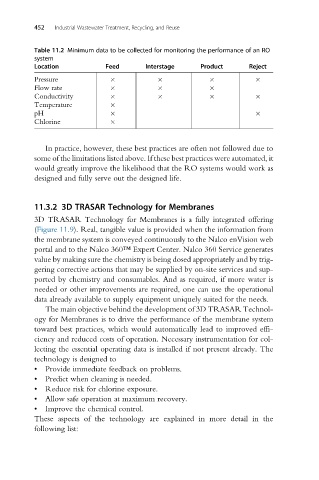Page 482 - Industrial Wastewater Treatment, Recycling and Reuse
P. 482
452 Industrial Wastewater Treatment, Recycling, and Reuse
Table 11.2 Minimum data to be collected for monitoring the performance of an RO
system
Location Feed Interstage Product Reject
Pressure
Flow rate
Conductivity
Temperature
pH
Chlorine
In practice, however, these best practices are often not followed due to
some of the limitations listed above. If these best practices were automated, it
would greatly improve the likelihood that the RO systems would work as
designed and fully serve out the designed life.
11.3.2 3D TRASAR Technology for Membranes
3D TRASAR Technology for Membranes is a fully integrated offering
(Figure 11.9). Real, tangible value is provided when the information from
the membrane system is conveyed continuously to the Nalco enVision web
portal and to the Nalco 360™ Expert Center. Nalco 360 Service generates
value by making sure the chemistry is being dosed appropriately and by trig-
gering corrective actions that may be supplied by on-site services and sup-
ported by chemistry and consumables. And as required, if more water is
needed or other improvements are required, one can use the operational
data already available to supply equipment uniquely suited for the needs.
The main objective behind the development of 3D TRASAR Technol-
ogy for Membranes is to drive the performance of the membrane system
toward best practices, which would automatically lead to improved effi-
ciency and reduced costs of operation. Necessary instrumentation for col-
lecting the essential operating data is installed if not present already. The
technology is designed to
• Provide immediate feedback on problems.
• Predict when cleaning is needed.
• Reduce risk for chlorine exposure.
• Allow safe operation at maximum recovery.
• Improve the chemical control.
These aspects of the technology are explained in more detail in the
following list:

